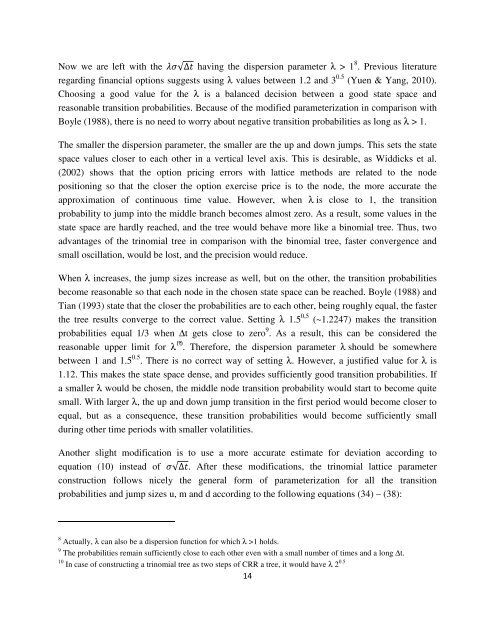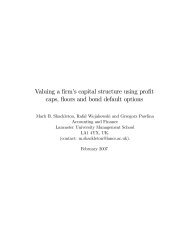Recombining Trinomial Tree for Real Option Valuation with ...
Recombining Trinomial Tree for Real Option Valuation with ...
Recombining Trinomial Tree for Real Option Valuation with ...
- No tags were found...
Create successful ePaper yourself
Turn your PDF publications into a flip-book with our unique Google optimized e-Paper software.
Now we are left <strong>with</strong> the √Δ having the dispersion parameter λ > 1 8 . Previous literatureregarding financial options suggests using λ values between 1.2 and 3 0.5 (Yuen & Yang, 2010).Choosing a good value <strong>for</strong> the λ is a balanced decision between a good state space andreasonable transition probabilities. Because of the modified parameterization in comparison <strong>with</strong>Boyle (1988), there is no need to worry about negative transition probabilities as long as λ > 1.The smaller the dispersion parameter, the smaller are the up and down jumps. This sets the statespace values closer to each other in a vertical level axis. This is desirable, as Widdicks et al.(2002) shows that the option pricing errors <strong>with</strong> lattice methods are related to the nodepositioning so that the closer the option exercise price is to the node, the more accurate theapproximation of continuous time value. However, when λ is close to 1, the transitionprobability to jump into the middle branch becomes almost zero. As a result, some values in thestate space are hardly reached, and the tree would behave more like a binomial tree. Thus, twoadvantages of the trinomial tree in comparison <strong>with</strong> the binomial tree, faster convergence andsmall oscillation, would be lost, and the precision would reduce.When λ increases, the jump sizes increase as well, but on the other, the transition probabilitiesbecome reasonable so that each node in the chosen state space can be reached. Boyle (1988) andTian (1993) state that the closer the probabilities are to each other, being roughly equal, the fasterthe tree results converge to the correct value. Setting λ 1.5 0,5 (~1.2247) makes the transitionprobabilities equal 1/3 when ∆t gets close to zero 9 . As a result, this can be considered thereasonable upper limit <strong>for</strong> λ 10 . There<strong>for</strong>e, the dispersion parameter λ should be somewherebetween 1 and 1.5 0.5 . There is no correct way of setting λ. However, a justified value <strong>for</strong> λ is1.12. This makes the state space dense, and provides sufficiently good transition probabilities. Ifa smaller λ would be chosen, the middle node transition probability would start to become quitesmall. With larger λ, the up and down jump transition in the first period would become closer toequal, but as a consequence, these transition probabilities would become sufficiently smallduring other time periods <strong>with</strong> smaller volatilities.Another slight modification is to use a more accurate estimate <strong>for</strong> deviation according toequation (10) instead of √Δ. After these modifications, the trinomial lattice parameterconstruction follows nicely the general <strong>for</strong>m of parameterization <strong>for</strong> all the transitionprobabilities and jump sizes u, m and d according to the following equations (34) – (38):8 Actually, λ can also be a dispersion function <strong>for</strong> which λ >1 holds.9 The probabilities remain sufficiently close to each other even <strong>with</strong> a small number of times and a long ∆t.10 In case of constructing a trinomial tree as two steps of CRR a tree, it would have λ 2 0.514



